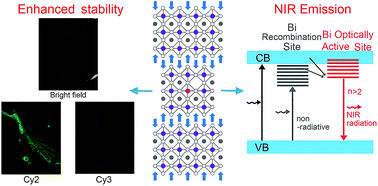Bi3+ doped 2D Ruddlesden–Popper organic lead halide perovskites†
Abstract
Two-dimensional Ruddlesden–Popper organic lead halide perovskites (2D RPPs) are semiconducting materials that have attracted widespread research attention recently. Fundamental understanding of heterovalent doping, a classical strategy to manipulate semiconductors′ optoelectronic and stability properties, is of great significance for their applications. Here we report the first series of heterovalent-doped 2D RPPs via Bi3+ doping for (BA)2(MA)n−1PbnI3n+1 (BA = n-C4H9NH3+; MA = CH3NH3+; n = 1, 2 and 3). Systematic experimental studies lead to the discovery of a positive correlation between the layer number and the doping level. Combined theoretical and experimental observations suggest the presence of two distinctive types of Bi3+ sites, a non-radiative recombination site at the organic/inorganic interface and a near-infrared (NIR) emission site at the middle Pb–I layer of the 3-layered 2D RPPs. Surprisingly, significantly improved photostability and environmental stability for the 2D RPPs were observed upon appropriate levels of Bi3+ doping. A fluorescence microscopy study suggests that a preferential doping-induced formation of 1L RPPs at the edges or cracks might act as a new mechanism to enhance the stability, providing an unprecedented strategy to improve the stability of perovskites and a new class of materials for device dimensionality engineering.



 Please wait while we load your content...
Please wait while we load your content...